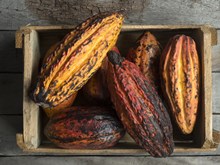Hot chocolate, or drinking chocolate to be more precise, is one of the oldest forms of preparing chocolate to enjoy. It is widely considered to be the Maya from South America who first discovered and developed the cocoa for culinary use, later the Aztecs as cocoa moved North into Mexico. The dried, roasted and ground cocoa was mixed with ingredients such as vanilla, herbs, honey, chillies and many other spices. No sugar or milk was ever used in drinking chocolate at this point. Frothed drinks and thick beverages were commonplace as hot and cold, drinkable and porridge like foods, often thickened with ground corn, still widely used in Latin American preparations today. These were the first masters of chocolate, building a sophisticated knowledge of the finest cocoa and how to nurture its growth and maximise its flavour.
Frothed chocolate drinks, using lime treated cocoa or special plants for the ultimate froth, were commonly used by the Aztecs for sacred offerings. Cocoa was once the most valuable commodity in South America to trade and later it was to take the status of money itself. It was at this point in history that Christopher Columbus encountered chocolate for the first time and the later ensuing Spanish missionaries observed the prestige associated with this new commodity. Cocoa at this point in time and geographical location was of the best quality, without adulteration, such as the fine flavour Criollo cocoa which was predominantly grown. The Spanish absorbed this respect and knowledge for cocoa and adopted the classification of origin, so important to determine the quality of flavour.
It was in the early seventeenth century that Spain adopted the habit of drinking chocolate, now becoming hot chocolate, although it took over 50 years to then spread to France and the rest of Europe. Drinking hot chocolate was only ever enjoyed by high society at this time. The ingredients combined with the drinking chocolate reflected this wealth. Sugar, a food for the rich, was used to sweeten the drinking chocolate along with exotic spices brought in from overseas. Traditional frothing agents were abandoned to simplify the process of making hot, drinking chocolate and instead the Mexican process of rotating a wooden stick with rings attached (called a molinillo) back and forth between the palms was adopted.
As chocolate production improved in each country and small factories began to industrialise and invent new processes, chocolate was becoming much more readily available to the masses, changing from a luxury commodity to an everyday snack. Notably in 1828, Conrad Van Houten of the Netherlands developed a process of mechanically extracting cocoa butter from “cocoa liquor”. The cocoa butter had many uses, particularly in cosmetics and the remaining solid cocoa could be ground to a powder. This made the creation of preparing drinking chocolate much easier. Other leaps forward from both Van Houten’s offsetting any acidity in poorer quality beans and Rodolphe Lindt’s invention of “conching”, a grinding process with cocoa and sugar that allowed a silky smooth melt we all know and love today.
At this point in history drinking hot chocolate had lost its high status altogether as so many varying chocolate snacks were being produced by the many brands now available. No longer was the origin or variety of the cocoa essential to understanding the products quality, a uniform taste was required for mass production and one that represented a brand, with its own secret recipe so the mix could not be copied. Whilst throughout Europe factories became bigger and more efficient, a few remained artisan and kept alive the traditional high standards of making chocolate.
Drinking hot chocolate is possibly the most indulgent form of enjoying chocolate, whatever mediocre products have tarnished its reputation over the years. True drinking chocolate should not contain artificial flavourings, powdered milk and preservatives. It is best enjoyed as pure as possible, as flavoursome as possible and in small quantities. Treat hot, drinking chocolate like an espresso or cappucino, not a huge mug full of over sweet milk with very little actual chocolate, with the main purpose of adding a beige colour and little flavour.
To make hot chocolate simply add some of our Superior Selection, 72% drinking chocolate flakes or Michel Cluizel 72% dark chocolate minigrams to hot milk, not boiling, and whisk until frothy. Add sugar if required or even a little chilli to re-create that traditional hot chocolate drink made by the aztecs. For decoration and pure indulgence top with a little cream and a few more chocolate flakes. Each person enjoys varying strengths of hot drinking chocolate so it is best to experiment to find your own personal favourite.
By The Chocolate Traveller
Chocolate Trading Company.









